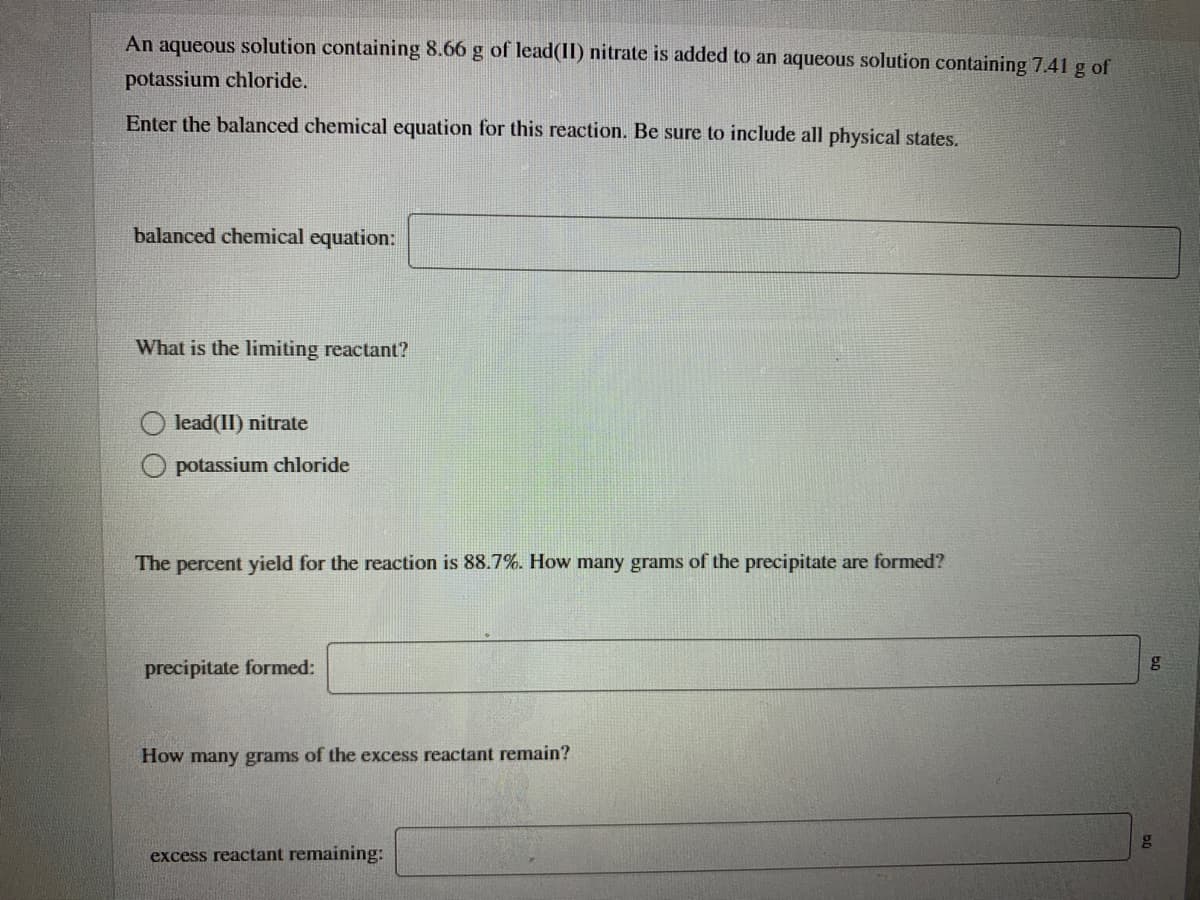An aqueous solution containing 8.66 g of lead(II) nitrate is added to an aqueous solution containing 7.41 g of potassium chloride. Enter the balanced chemical equation for this reaction. Be sure to include all physical states. balanced chemical equation: What is the limiting reactant? O lead(II) nitrate O potassium chloride The percent yield for the reaction is 88.7%. How many grams of the precipitate are formed? precipitate formed: How many grams of the excess reactant remain? excess reactant remaining:
An aqueous solution containing 8.66 g of lead(II) nitrate is added to an aqueous solution containing 7.41 g of potassium chloride. Enter the balanced chemical equation for this reaction. Be sure to include all physical states. balanced chemical equation: What is the limiting reactant? O lead(II) nitrate O potassium chloride The percent yield for the reaction is 88.7%. How many grams of the precipitate are formed? precipitate formed: How many grams of the excess reactant remain? excess reactant remaining:
Introductory Chemistry: A Foundation
9th Edition
ISBN:9781337399425
Author:Steven S. Zumdahl, Donald J. DeCoste
Publisher:Steven S. Zumdahl, Donald J. DeCoste
Chapter9: Chemical Quantities
Section: Chapter Questions
Problem 56QAP: Although many sulfate salts are soluble in water, calcium sulfate is not (Table 7. 1). Therefore, a...
Related questions
Question

Transcribed Image Text:An aqueous solution containing 8.66 g of lead(II) nitrate is added to an aqueous solution containing 7.41 g of
potassium chloride.
Enter the balanced chemical equation for this reaction. Be sure to include all physical states.
balanced chemical equation:
What is the limiting reactant?
lead(II) nitrate
potassium chloride
The percent yield for the reaction is 88.7%. How many grams of the precipitate are formed?
precipitate formed:
How many grams of the excess reactant remain?
excess reactant remaining:
Expert Solution
This question has been solved!
Explore an expertly crafted, step-by-step solution for a thorough understanding of key concepts.
Step by step
Solved in 4 steps

Knowledge Booster
Learn more about
Need a deep-dive on the concept behind this application? Look no further. Learn more about this topic, chemistry and related others by exploring similar questions and additional content below.Recommended textbooks for you

Introductory Chemistry: A Foundation
Chemistry
ISBN:
9781337399425
Author:
Steven S. Zumdahl, Donald J. DeCoste
Publisher:
Cengage Learning

Introductory Chemistry: An Active Learning Approa…
Chemistry
ISBN:
9781305079250
Author:
Mark S. Cracolice, Ed Peters
Publisher:
Cengage Learning


Introductory Chemistry: A Foundation
Chemistry
ISBN:
9781337399425
Author:
Steven S. Zumdahl, Donald J. DeCoste
Publisher:
Cengage Learning

Introductory Chemistry: An Active Learning Approa…
Chemistry
ISBN:
9781305079250
Author:
Mark S. Cracolice, Ed Peters
Publisher:
Cengage Learning


World of Chemistry, 3rd edition
Chemistry
ISBN:
9781133109655
Author:
Steven S. Zumdahl, Susan L. Zumdahl, Donald J. DeCoste
Publisher:
Brooks / Cole / Cengage Learning

Chemistry: The Molecular Science
Chemistry
ISBN:
9781285199047
Author:
John W. Moore, Conrad L. Stanitski
Publisher:
Cengage Learning

Chemistry: Matter and Change
Chemistry
ISBN:
9780078746376
Author:
Dinah Zike, Laurel Dingrando, Nicholas Hainen, Cheryl Wistrom
Publisher:
Glencoe/McGraw-Hill School Pub Co